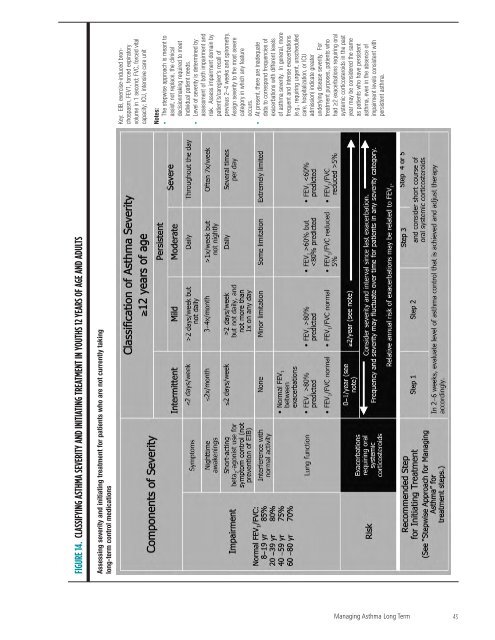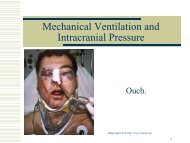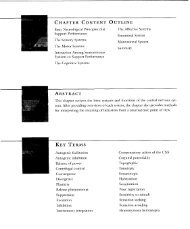Guidelines for the Diagnosis and Management of Asthma
Guidelines for the Diagnosis and Management of Asthma
Guidelines for the Diagnosis and Management of Asthma
Create successful ePaper yourself
Turn your PDF publications into a flip-book with our unique Google optimized e-Paper software.
FIGURE 14. CLASSIFYING ASTHMA SEVERITY AND INITIATING TREATMENT IN YOUTHS 12 YEARS OF AGE AND ADULTS<br />
Assessing severity <strong>and</strong> initiating treatment <strong>for</strong> patients who are not currently taking<br />
long-term control medications<br />
Key: EIB, exercise-induced bronchospasm,<br />
FEV1, <strong>for</strong>ced expiratory<br />
volume in 1 second; FVC, <strong>for</strong>ced vital<br />
capacity; ICU, intensive care unit<br />
Notes:<br />
• The stepwise approach is meant to<br />
assist, not replace, <strong>the</strong> clinical<br />
decisionmaking required to meet<br />
individual patient needs.<br />
• Level <strong>of</strong> severity is determined by<br />
assessment <strong>of</strong> both impairment <strong>and</strong><br />
risk. Assess impairment domain by<br />
patient’s/caregiver’s recall <strong>of</strong><br />
previous 2–4 weeks <strong>and</strong> spirometry.<br />
Assign severity to <strong>the</strong> most severe<br />
category in which any feature<br />
occurs.<br />
• At present, <strong>the</strong>re are inadequate<br />
data to correspond frequencies <strong>of</strong><br />
exacerbations with different levels<br />
<strong>of</strong> asthma severity. In general, more<br />
frequent <strong>and</strong> intense exacerbations<br />
(e.g., requiring urgent, unscheduled<br />
care, hospitalization, or ICU<br />
admission) indicate greater<br />
underlying disease severity. For<br />
treatment purposes, patients who<br />
had ≥2 exacerbations requiring oral<br />
systemic corticosteroids in <strong>the</strong> past<br />
year may be considered <strong>the</strong> same<br />
as patients who have persistent<br />
asthma, even in <strong>the</strong> absence <strong>of</strong><br />
impairment levels consistent with<br />
persistent asthma.<br />
Managing <strong>Asthma</strong> Long Term<br />
43





